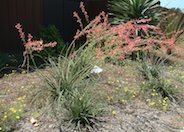
Common name:Red Yucca
Botanical name:Hesperaloe parviflora
This spectacular succulent is wonderful for a desert garden, with rosettes of gray green leaves to about 3'-4' tall and 6' wide. Red flower stalks emerge during spring and remain on the plant until the end of summer. This shrub will spread to form a crowded grass-like clump. This evergreen shrub is drought resistant but will appear better and bloom longer with added moisture. It does well in full sun, reflected heat, poor soils and cold temperatures to at least 0 degrees F.
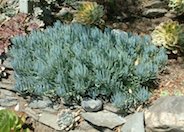
Common name:Kleinia
Botanical name:Senecio mandraliscae
This succulent perennial will grow to about 1.5' tall and 2' wide. It has curved, bluish gray leaves that are about 3.5" long and very slender.
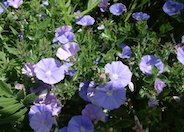
Common name:Dwarf Morning Glory
Botanical name:Convolvulus sabatius
Convolvulus sabaticus is a perennial that grows 1'-2' high, with branches that spread to 3' or more. It produces blue to lavender flowers with blooms of 1"-2" wide. The soft, evergreen leaves are 1/2" to 1.5" long.
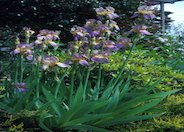
Common name:Bearded Iris
Botanical name:Iris Bearded Hybrids
This perennial will grow 1'-3' tall and has medium sized, blue green leaves with flowers of different colors that bloom in spring. It needs well draining soil and full sun. Many are fragrant and rebloom several times a year. Plant rhizomes in Sept or Oct. They need water once a week during the hot spells. Top dress with compost and gypsum in January and August.

Common name:Blue Star Creeper, Isotoma
Botanical name:Pratia pedunculata
Pratia pedunculata has bright green, nearly stemless, 1/4" leaves. In late spring and summer, these form a backdrop for equally tiny, star-shaped pale blue flowers.

Common name:Hybrid Gazanias
Botanical name:Gazania hybrids
These ground covers will grow less than 1' tall and have medium size, gray green leaves with gold, lavender, orange, red, yellow, or white flowers that are present all year.
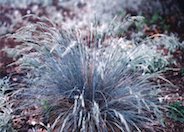
Common name:Superba Fescue
Botanical name:Festuca amethystina 'Superba'
The Rainbow Fescue is a hardy fescue with fine, blue green foliage that grows 8" tall. It has spring flowers that are 12" above the foliage. This fescue is a very showy, neat grass for sunny spots during spring and fall. The Rainbow Fescue is drought tolerant. -Cornflower Farms

Common name:Amazing Red Flax
Botanical name:Phormium 'Amazing Red'
Phormium 'Amazing Red' is an evergreen perennial. It is a 2' tall, dramatic plant composed of many swordlike, stiffly vertical leaves in a fan pattern. Leaves are dark reddish brown in color.

Common name:Hollywood Twisted Juniper
Botanical name:Juniperus chinensis 'Kaizuka'
The dark green foliage on the branches of this Juniper start in a narrow cone shape when young but open up gracefully when older. Its twisted looking branches resemble flames. It may grow 15' tall in 15 years. Over time, the branches may lean to one side. Junipers are highly combustible plants.

Common name:Star Magnolia
Botanical name:Magnolia stellata
This slow-growing, shrubby, deciduous Magnolia has narrow leaves about 4" long and 1" wide. These fragrant flowers, borne in the early spring before leaves, are white, with 19-21 star-shaped petals.
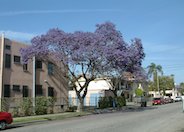
Common name:Jacaranda
Botanical name:Jacaranda mimosifolia
This irregular to rounded deciduous tree will reach about 40' tall and has fine, compound green leaves with blue flowers. Jacaranda's main blooming season is in spring and summer, but it will often produce sporadic blooms in fall as well.
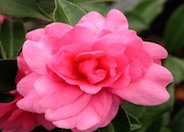
Common name:Sansanqua or Sun Camellia
Botanical name:Camellia sasanqua
In contrast to other Camellias, this broad-leaved evergreen shrub has small foliage and a more open habit. Its long shoots are easily trained on a wall or fence. Flowering occurs in the fall to early winter, and produces single to fully double blossoms. There should be an incorporation of organic material into the planting bed.
| Designer: | Organic Look Pavers |
Photographer: GardenSoft |
Soils and Compost:
Maintain a two to four inch layer of mulch on the soil surface to reduce weeds, infiltrate rain water, and reduce compaction.
Integrated Pest Management:
Develop healthy soil for plants that are vigorous and naturally pest-resistant.

